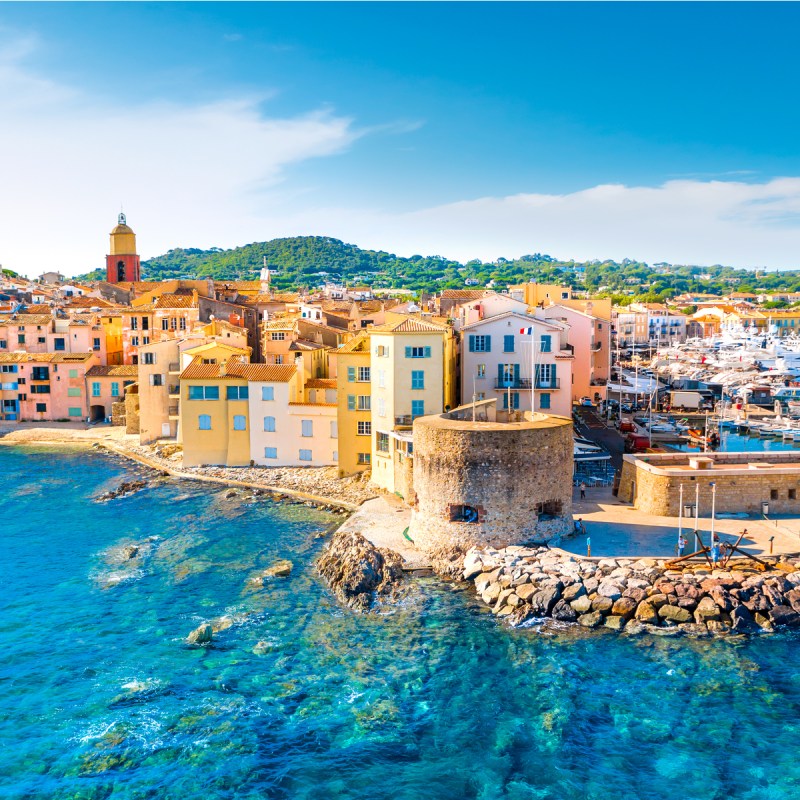
France is blessed with three very different coastlines hemming the country on three sides and stretching over 2,000 miles. In the north, there is the English Channel, a coast made up of a mix of white sandy beaches in the east and rugged, rocky coves to the west. Along the entire west coast of France, the country connects with the Atlantic Ocean, and from Saint-Nazaire southward, that coast is mostly endless, white sandy beaches, with beautiful sand dunes welcoming big ocean waves. Then there is the Mediterranean, bordering France’s southern coast. This is where the famous resort towns of St. Tropez, Nice, and Cannes lie, and society famously tends to congregate. The three coasts could not be more different from each other, but in this article, we can only compare two, so I opted for the two most popular with overseas visitors: the Atlantic coast and the Mediterranean coast.
Videos by TravelAwaits
Growing up in Germany, France was a mere drive away, and I spent many summer weeks of my childhood on the French Atlantic coast, with most French vacations spent along that endlessly straight, sandy stretch south of the Garonne estuary reaching all the way down to Saint-Jean-de-Luz and the Spanish border. I only visited the French Mediterranean coast later in my teens but have since made up lost ground.

Both coastlines offer superb reasons to favor one over the other; it is really quite an individual thing to decide which one ticks your boxes and which one to choose for a vacation. You could, of course, if you have time, visit both and maybe even travel along the water all the way between them, because the Atlantic coast is connected with the Mediterranean coast by the Canal du Midi, which goes via Toulouse.
Here I highlight some of the main differences between both coastlines to try and help you decide whether you belong to team Atlantic or team Mediterranean.

1. Location, Size, And Population
The Atlantic coast runs between the Loire estuary at Saint-Nazaire, past the islands, of which the most famous is the gorgeous Île de Ré, across the Garonne Estuary which leads inland to Bordeaux, down past the stunning Cap Ferret and Arcachon, famous for its oysters, ending at chic Biarritz close to the Spanish border, with foodie heaven San Sebastian just a brief drive away. It is the longest of the coastlines, and also probably the least populated — with many smaller resort towns being surrounded by the thick pine forests that reach nearly to the beach and make for beautiful dunes and campsites. The beaches are long and wide, allowing for plenty of space for everyone.

The Mediterranean coast meanders from Perpignan at the foot of the Pyrenees past Montpellier, the Camargue to Marseilles, and then gets chicer and more expensive with every town, from St. Tropez to Cannes, Antibes to Nice, and then ending at the border to Monaco. This is busy territory, which in summer is completely overbooked with beaches split into sun lounge-size segments that you can rent at a premium.

2. Climate
The Atlantic coast is warm and sunny in summer, reaching temperatures of the high-70s Fahrenheit, but with it being open to the ocean, it can be windy and typically has lower temperatures than the Mediterranean coast, while the open Atlantic is noticeably colder than the more sedate waters of the Mediterranean. The French Riviera at the eastern end of the Mediterranean coast is on average the warmest place in France, with warm to hot weather in summer reaching temperatures of 80 degrees and above.

3. Getting Around
On both sides, you would vastly benefit from having a car to allow you to discover the hidden beaches and the lesser-visited areas. That said, France’s rail network is nothing if not extensive and fast. You can get down the Atlantic Coast from Nantes to La Rochelle, but then need to go around the Garonne estuary via Bordeaux to then get back to the coast at Arcachon and south to Bayonne and Biarritz. These train lines follow the coastline roughly but do not take you directly to the beaches.
On the Mediterranean coast, there are many more trains, and not just the fast connections (TGVs), but trundling, local ones which do get you closer to the beaches. In fact, one of Europe’s most scenic train journeys takes you from Antibes via Monaco into Italy, right along the coast with fantastic views.

4. Good Bases Along The Way
Of course, you can choose one spot along either coast and stay there for your entire vacation, which is fine, as there are some beautiful beaches on both coasts. But if you want to take day trips and explore a bit more of the region, it is good to have a base that offers you everything you need, plus access to beaches and other attractions.
On the Atlantic side, La Rochelle is perfect for the islands and the stretch north of the Garonne. From there you have interesting cities such as Poitiers, Tours, and Limoges, plus easy access via bridges to the islands of Ré and Oléron. Arcachon is perfect for exploring Cap Ferret, while Bordeaux is not far from the coast either, and has the vineyards nearby. Further south, stay at Mimizan or Saint Jean de Luz.
Along the Mediterranean, the choices are nearly endless, budget allowing. I love Montpellier, from where you can take the tram and local bus to some fabulous beaches while staying in the lovely city and being close to Nimes and Avignon. Hyères is cute and not quite as overrun as St. Tropez, and you can explore up and down the coast from there; then there are the large centers such as Nice, and the super-cute Menton, great for popping across to Monaco and Italy.

5. The Vibe
The vibe is very different on both coasts, with the Atlantic coast being family-friendly, lots of campsites nearby under the pine trees, with incredibly wide, long beaches which come mostly without the options of hiring sun loungers or a waiter bringing you a cocktail.
In stark contrast, on the right beaches along the Mediterranean that is the norm, and you also need to dress up rather than down. Of course, there are plenty of “normal” beaches outside of the expensive hotspots as well, where you can just bring your own picnic, but on the whole, think chic and expensive along the Med, and relaxed and impromptu along the Atlantic.

6. Suitability For Travelers Of All Ages
If you are traveling with older grandkids, potential surfers, and true water babies, then I would definitely suggest the Atlantic coast, where the waves are spectacular and you can get tumbled around all day. That said, there are some more secluded beaches on the islands that are perfect for all ages. Equally, while it gets hot during a perfect summer’s day, the water is always refreshing, so if you have a tendency to overheat, this might be the coast for you.
For smaller kids, the Mediterranean is a little safer, and there is a large waterpark at Frejus for a fun day out. At Cannes, you have the underwater museum, which is great to visit for snorkelers and scuba divers.
If you require wheelchair access, look for the sign saying “handiplage,” meaning handicapped beach, offering wheelchair access. The two best handiplages around Nice are Plage du Centenaire and Plage de Carras, but there are many good wheelchair beaches along both coasts, with this map giving you a better idea.

7. Cost
On the whole, you can do France as cheaply or as expensively as you like. When I was young, my dad and I often camped in Vieux-Boucau-les-Bains, under the pine trees, with the stunning beach just behind the tall dunes. In turn, when my daughter was still tiny, we all used to drive down to the Île de Ré and either stayed in a campervan or a small chalet on a campsite by the beach, with relatively cheap restaurants on-site and just treated ourselves when funds allowed it to the odd night out in Saint-Martin-de-Ré.
But I have also stayed in rather nice hotels along the French Riviera, having cocktails along the Promenade des Anglais in Nice, cocktails that cost more than one night on the campsite on the other coast. I thoroughly enjoyed both; each was appropriate at the time, and suitable for the then travel budget.
For both coasts, you can save yourself a lot of money, and enjoy a much thinned-out crowd if you avoid July and August and instead arrive in early September. The weather is still superb, the water still warm, and you can actually find a seat on a café terrace, and afford a night or two in an exclusive hotel, or upgrade your chalet to one with a balcony and a view.
Whether you choose the Atlantic or the Mediterranean coast, there is no doubt that you will truly enjoy either. The French love a beach vacation, and good restaurants even on a beach, and café terraces for coffee and the all-important aperitif can be found everywhere. You cannot set foot anywhere near the edge of France without stumbling onto a gorgeous beach, so fret not about choosing the perfect one from afar. Just go, and you will find one not far from you.
For more ideas on travel in France, explore these articles:
